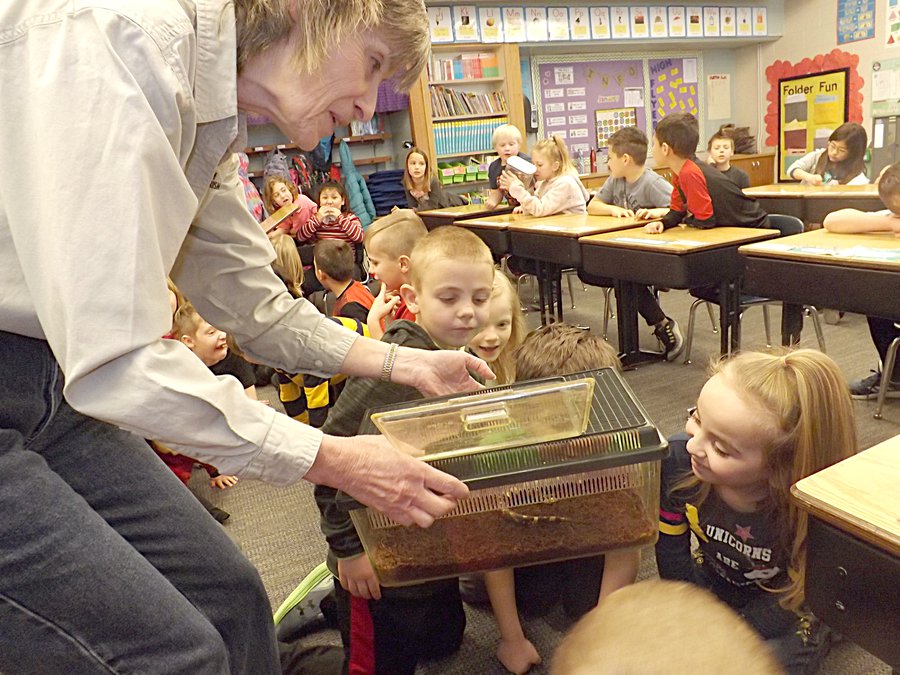With Kansas Day fast approaching, Pam Martin from the Kansas Wetlands Education Center has spent the month visiting second-grade classrooms throughout the area. Martin’s program Friday at Jefferson Elementary School in Great Bend included a couple of living examples of our state symbols.
There was a barred tiger salamander and an ornate box turtle, the official state amphibian and reptile. Students had to sit on their hands as Martin approached them with Ernie, the turtle, because while most box turtles are safe to pick up and usually will not bite humans, they are still wild animals. The salamander stayed in its container, but the children got to see its markings and a mouth that makes it appear to always be smiling. “They’re always happy to see you!” Martin said.
Wednesday, Jan. 29, is Kansas Day, which Martin compared to a state birthday.
“Kansas will be 159 years old,” she said. Back when Kansas became a state, the Legislature began to adopt symbols to give people some information about us, she explained. With many of those symbols being plants or animals, who better to give a program than a biologist such as Martin? She works at the KWEC as an environmental educator with the Kansas Department of Wildlife, Parks and Tourism.
Here are a few state symbols and facts that Martin mentioned in her program:
Kansas State Grass: Little Blue Stem
Kansas State Animal: American Bison. Native American Indians used every part of the bison. Historians have identified 120 items made from bison for food, clothing and tools.
Kansas State Insect: Honeybee. Specifically, Martin said, our state insect is the Western or European honeybee, which came to North America on ships from Italy. Martin had a second-grader wear a bee costume and lead the others in a circle dance and a waggle dance, which is how bees tell their fellow workers the location of a new nectar or pollen food source. A queen bee, who lay eggs daily, lives in a colony or hive with about 80-100 males (drones) and 35,000 worker bees (all female).
Kansas State Amphibian: Barred Tiger Salamander. Unlike reptiles, amphibians have no scales, claws or teeth. “They’re very gentle,” Martin said. “He doesn’t have much to protect himself.” But the salamanders' yellow and black markings warn predators that they are poisonous; they have tail glands that can secrete drops of a toxic milky substance. Barred tiger salamanders are common to Kansas and are the world’s largest species of land-dwelling salamander.
Kansas State Reptile: Ornate Box Turtle. They are called “box turtles” because they have a hinge on their lower shell that allows them to withdraw their head and feet and form a closed box that protects them from predators. The ornate box turtle has a domed round upper shell. They can’t swim like some other turtle species with flatter shells, such as the red-eared slider or the western pond turtle. You can tell the sex of a box turtle because a male has orange scales and bright red eyes while a female has yellow scales and yellow eyes. They live for about 50 years. Much like the rings on the trunk of a tree, as a turtle ages it develops rings in its scutes, the plates that make up its shell.
Kansas State Bird: Western Meadlowlark. “In this part of the state we have both Eastern and Western Meadlowlarks,” Martin said. “You can tell the difference by their songs.” She played recordings of both for the children.
Kansas State Tree: Cottonwood. They can grow to be 100 feet tall.
Kansas State Flower: Sunflower. Phototropism is the process that causes plants to bend toward sunlight. Before they develop their seeds, young sunflower plants start each morning with the stalks and buds facing east and follow the path of the sun from east to west during the day. During the night, they move back to face the east.





